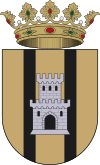Castelló de Rugat facts for kids
Quick facts for kids
Castelló de Rugat
|
||
|---|---|---|
|
||
| Country | ||
| Autonomous community | ||
| Province | Valencia | |
| Comarca | Vall d'Albaida | |
| Judicial district | Ontinyent | |
| Area | ||
| • Total | 19.1 km2 (7.4 sq mi) | |
| Elevation | 320 m (1,050 ft) | |
| Population
(2018)
|
||
| • Total | 2,275 | |
| • Density | 119.1/km2 (308.5/sq mi) | |
| Demonym(s) | Castellonenc, castellonenca | |
| Time zone | UTC+1 (CET) | |
| • Summer (DST) | UTC+2 (CEST) | |
| Postal code |
46841
|
|
| Official language(s) | Valencian | |
Castelló de Rugat (also known as Castellón de Rugat in Spanish) is a small town in the Valencian Community, Spain. It is located in a region called Vall d'Albaida. This town is a municipality, which means it has its own local government.
Contents
Exploring Castelló de Rugat's Geography
Castelló de Rugat is found on the eastern side of the Vall d'Albaida region. It sits north of the Benicadell Mountains. The town's area is about 20 square kilometers. Most of this land is used for farming. The rest is made up of valleys and mountains.
The highest points are La Lloma de l'Ullastre (820 meters) and Peña Blanca (530 meters). The town itself is about 320 meters high, located near L'Ermita hill. The Benicadell Mountains form a natural border. To the north, west, and east, the land is flatter with many small valleys.
Towns Near Castelló de Rugat
Castelló de Rugat shares borders with several nearby towns. These include Aielo de Rugat, Beniatjar, Llutxent, Pobla del Duc, El Ràfol de Salem, Rugat, and Salem. All these towns are in the Valencia Province. It also borders L'Orxa, which is in the Alicante Province.
A Look Back at Castelló de Rugat's History
The area around Castelló de Rugat has been home to people for a very long time. Scientists have found signs of early humans from the Neolithic period (New Stone Age) in caves like Llopis and La Cerradura. More ancient tools and remains were found in places like L'Ofra and El Planet.
Later, during the Bronze Age, villages existed at Buitrera and Peña Blanca. The Roman Empire also left its mark here. A large Roman villa was recently discovered at L'Ofra.
The Christian reconquest of this area was led by King James I of Aragon. It was a tough fight against the Muslim leader Al Azraq. After the Christians took control, the land became part of the Rugat Baron's property. It was later bought by the Duke of Gandia in 1499. This is why the town was then called Castelló del Duc.
Most of the people living here were moriscos (Muslims who had converted to Christianity). In 1609, King Felipe III ordered all moriscos to leave Spain. This caused Castelló to lose many of its people. The town remained under the Duke's control until 1812. That year, a new constitution ended the power of the nobility.
How People Make a Living in Castelló de Rugat
For a long time, the economy of Castelló de Rugat was based on farming. Farmers grew cereals and grapes. Later, they started growing fruit trees. The town was also famous for making clay jars.
Today, farming is still important, but it's not the only job. There is a farming cooperative and many fruit stores that export fruits. This helps keep the farming sector strong.
Castelló also has many different services, like shops and businesses. This makes it a busy place for people from other nearby towns. There are also farms that raise chickens, lambs, pigs, and produce eggs. In recent years, the construction industry has also grown a lot. The town is also known for making decorative ceramics used in buildings.
Places to See in Castelló de Rugat
Castelló de Rugat has many interesting historical places to visit.
- Ermita de San Antonio: This old chapel is dedicated to Saint Anthony and Saint Barbara. It was built in the 1600s and later repaired.
- Iglesia de la Asunción: This is the town's main church. Its construction started in 1536. Inside, it has three main sections and a dome.
- Mezquita: This mosque is located in the old part of town. It is one of the few mosques left from the time of Muslim rule in Spain. This makes it very important for historians.
- Palacio Ducal: These are the remains of a palace built by the Bellvis family. Later, the Borja family (also known as the Borgias) owned it. The Dukes of Gandia used it as a summer home.
- Horno Alfarería: This is the oldest kiln in the town. It was part of the ceramics industry that made Castelló famous.
- Neveras: These are old ice houses from the 1500s to 1800s. They were used to store snow collected in winter. This snow would then be used in summer to keep food fresh, make ice cream, and even as medicine to lower fevers. The best one is at dels Racons.
- La Font: This fountain from the early 1900s gives its name to a well-known street. Nearby is "el llavador," an old washing place, and "bassa de la font," a pool used for irrigation. A popular festival event happens here.
- Casa Frasquet: This was the home of a rich local family. It was built in the 1700s. It was also known as "the pharmacy" because it housed one for many years.
- La Torre: This was a country house built like a Moorish tower in the mid-1800s. Today, only ruins remain.
See also
 In Spanish: Castellón de Rugat para niños
In Spanish: Castellón de Rugat para niños



